Silkie Rooster: Hen vs. Rooster (With Pictures)
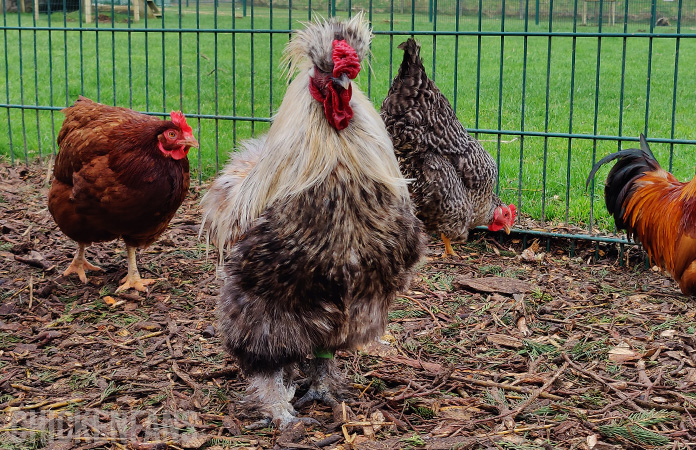
Silkies are a favorite pet chicken for many chicken owners with small children. They are friendly and sweet, and even roosters are very docile and sociable. If you plan on keeping a Silkie rooster, there are some things to remember.
Let’s start with some key takeaways about a Silkie Rooster
| Lifespan | Up to 10 years |
| Body Type | Broad body, short back with ragged tail |
| Feathers | Fluffy and soft |
| Weight | 3-4 lbs |
| Hardiness | Cold hardy |
| Temperament | Docile and friendly |
| Beginner-friendly | Yes |
| Color | Varies |
Characteristics
Silkies are very popular among chicken keepers because of their friendly personality and fluffy look. They make excellent pet chickens. Their appearance is very recognizable as they look nothing like ordinary laying breeds.
Due to their distinctive look, Silkies are mostly bred for ornamental purposes or to participate in poultry shows. They are miniature chickens, with roosters weighing around 3 to 4 pounds (1.3-1.8 kg) and hens up to 2 pounds (900 gr).
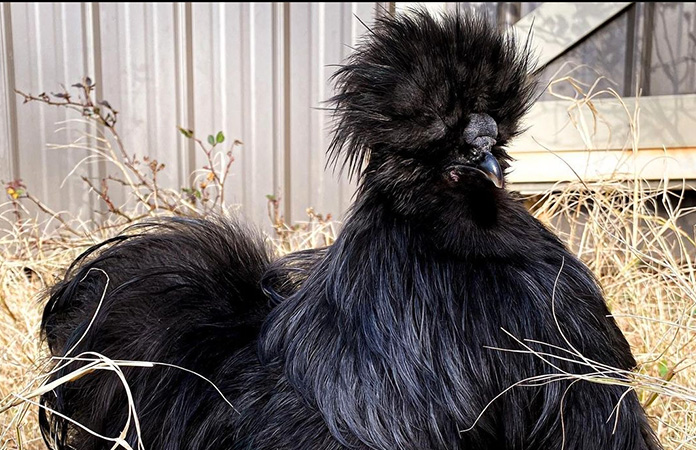
Silkies come in both bearded and clean-faced varieties. Other unusual characteristics include black skin and bones, five toes on each foot, blue earlobes, and they lack the ‘hooks’ on their feathers.
If you want to learn more about the Silkie breed, check out our breed article on ‘Silkie Chickens‘.
Are Silkie Roosters Friendly?
Silkie chickens are among the friendliest chicken breeds in the world. They make excellent companions for kids and are great pets. But the roosters take their task to protect the flock very seriously, although Silkie Roos are known to be friendlier than most other male chicken breeds.
Certain chicken breeds are generally more prone to aggressive or assertive behavior than others. A Rhode Island Red, for example, is typically described as vocal and confident. Nevertheless, many chicken keepers claim their Rhode Island Red rooster is the sweetest of the bunch.
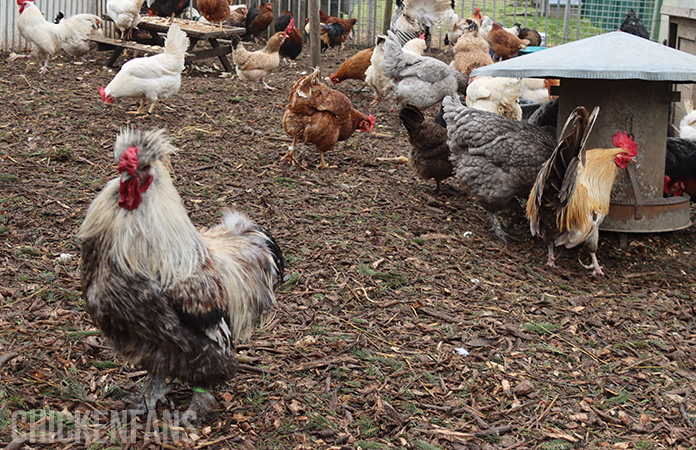
It all comes down to a chicken’s personality. All roosters have their own individual temperament, which doesn’t necessarily match the breeds’ typical characteristics. But we must be clear that a Silkie rooster is likelier to be sweet and friendly than most other chicken breeds.
In most cases, an assertive rooster benefits your flock, as they are the protector and leader. The rooster takes his task of coop protector very seriously.
Only when your rooster starts showing aggressive behavior toward the hens, or toward you, as a chicken keeper it’s best to take action and try to calm him down. You can use pinless peepers to stop aggressive behavior toward other flock members.
Silkie Rooster Vs Hen
Overall, the difference between a Silkie rooster and a Silkie hen is shown in their physical characteristics as adult birds. It’s not easy to determine the sex of a Silkie chick; you’ll have to wait until they are fully mature.
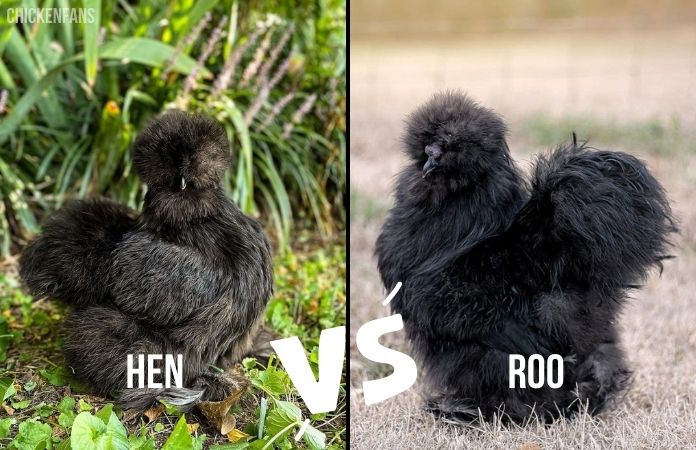
It’s important to understand the differences between a Silkie rooster and a Silkie hen, not only to sex your flock but also for reproductive or behavioral reasons.
How to Tell if a Silkie is a Rooster?
Silkies are one of the most different breeds to sex at a young age, so it’s always best to wait until they have matured. Once a Silkie has reached the age of 10 weeks, a trained eye can tell the difference between a rooster and a hen.
If you want to be 100% sure, you’ll need to wait until they eighter start to crow or lay eggs. But there are several physical differences between Silkie roosters and hens.
- Size: Roosters are heavier and larger
- Wattles: Silkie males develop wattles sooner
- Comb: A roo comb is often much larger than a hen’s comb and it’s walnut-shaped instead of V-shaped
- Spurs: Roosters grow spurs, hens don’t
- Feathers: Roosters have sickle feathers; hens don’t. And the crown feathers of a Silkie hen are more round and tidy.
- Stand: Silkie males will stand more upright than females.
Other Differences:
Silkies are very hard to sex at a young age. But next to the main differences, another possible characteristic of a male Silkie is to have ticker feathers on their feet than females.
And, of course, if your chicken starts to crow, you can be almost certain it’s a rooster. Some hens also crow or make crow-like noises, but it usually doesn’t start at a young age but will happen when they are trying to get on top of the pecking order as an adult bird.
Do Silkie Roosters Crow?
Yes, Silkie roosters can and will crow. Roosters crow to communicate, lead their flock and warn of danger. Silkie cockerels are no exception to this rule. They will start crowing at the age of 3 months or later and have a little less volume to their crow than large birds.
The age at which a rooster begins to crow can vary depending on the breed. Most bantam roosters start to crow at the young age of 2 – 3 months, while large slower-maturing breeds may not crow for the first time until they are 8 to 10 months old.
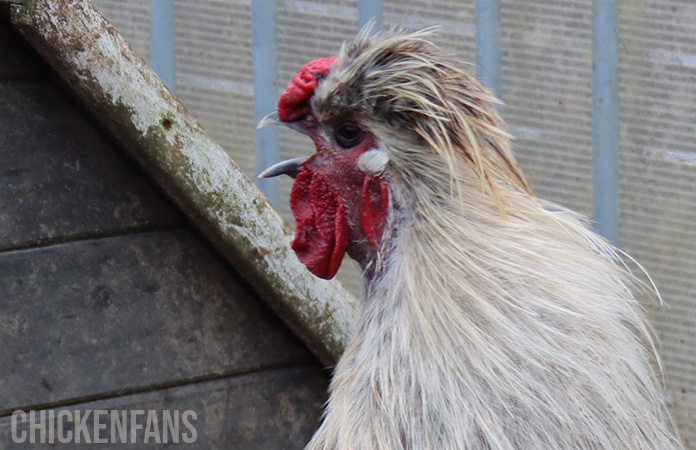
Can You Eat Silkie Roosters?
Yes, but remember that Silkies are small chickens that won’t bring much meat to the table. They also have black skin and bones, so their meat will look completely different from any other chicken meat you are used to. Silkies are considered a delicacy in certain cuisines.
If you are looking for a chicken that can bring you a lot of meat, a Silkie is not the best breed for you. Consider other larger and heavier breeds, like Brahmas or Orpingtons. But if you have the necessity to cull a Silkie rooster, it’s good to know you can eat their meat without any issues as long as the bird is healthy.
How Long Do Silkie Roosters Live?
On average, a Silkie rooster can get 10 years old, but most live until the age of 6 to 10. Their lifespan depends on several factors, like overall health, living circumstances, and the feed they have been given. Silkies are a heritage breed, and they tend to live longer than hybrid chickens.
Providing adequate nutrition, clean living spaces, and regular veterinary check-ups can help ensure your Silkie rooster’s long and healthy life.
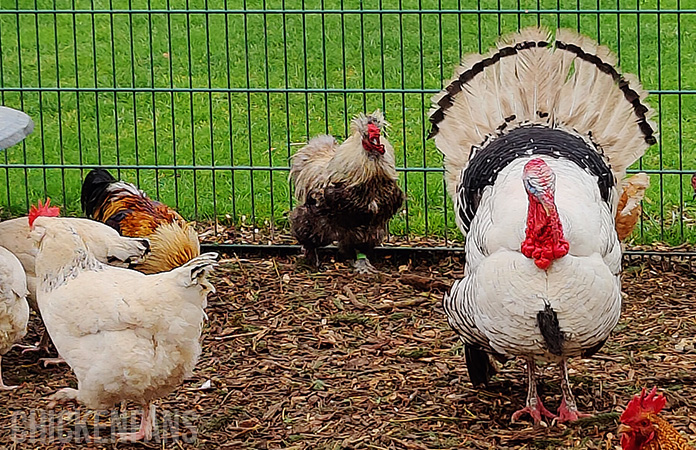
Do Roosters Live Longer Than Hens?
On average, hens usually live longer than roosters. This is mainly because roosters are more active and aggressive and may suffer injuries during fights. Additionally, roosters’ bodies are often under more stress due to their role in protecting the flock and reproduction.
With proper care and when kept in captivity, most roosters have a lifespan of somewhere between five to ten years.
Summary
Silkie roosters are smaller than other roosters, and their feathers lack barbicels, giving them a fur-like appearance. They are docile, making them suitable as pets, and tend to be good protectors of their flock.
It’s difficult to spot the difference between hens and roosters, especially young ones. To be 100% certain, waiting until they start to crow or lay an egg is best.
If you want to learn more about chicken breeds, please visit our ‘Breeds‘ page.
Credits Photos Black Silkies: @persnicketpoultry (IG)






















